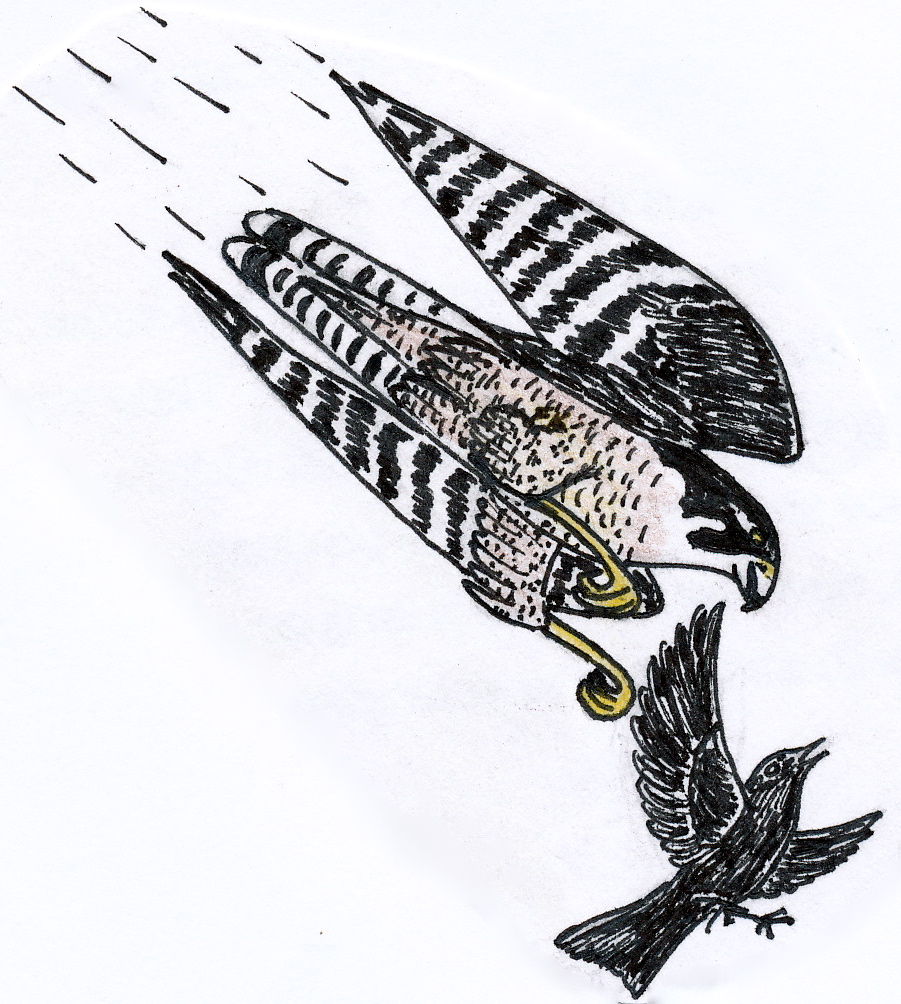Peregrine falcon
Have you ever wondered what it might be like being a Peregrine falcon? Imagine hurtling towards the ground at more than 200 mph in pursuit of a duck or ptarmigan or even one of your mortal enemies, a golden eagle. Imagine how it would feel at that speed hitting your prey with fist-clenched talons, then sommersaulting in mid-air to come around and grab it. Pretty amazing picture, isn’t it? Well, Peregrine falcons are amazing birds. Let me tell you a little about them.

I learned first-hand about peregrines when I volunteered several years ago to help a friend band peregrine nestlings for two weeks along the Porcupine River. The Porcupine is a tributary of the Yukon River located in northeast Alaska, and probably has more of these falcons than any other Yukon tributary in Alaska. It was our job to census and band every fledgling peregrine on the river. As you can imagine, I learned more about these fascinating birds in two weeks than I had in fifty years before that.
Biologists like my banding partner Fran Mauer refer to this bird as Falco peregrinus, which is Latin for “wandering falcon,” since it will sometimes travel half-way around the world during its migration journey. It has many common names, the most common of these being, “duck hawk,” because it often feeds on small ducks. Closer to home, on the YK Delta, the peregrine is known as “qiirayuli,” which in Yupik means “the one who calls qee qee qee qee” when disturbed.
The peregrine was until fairly recently one of the most widespread of all bird species, reaching to the ends of the Earth except Antarctica. Since the widespread use of the insecticide DDT in the 1950’s, however, the species became almost extinct in many parts of the world, including the United States. Only since the Endangered Species Act of 1973 has it made a comeback, mostly through captive breeding progams and protection offered by the U.S. Fish and Wildlife Service. Thanks to them and concerned citizens, the return of the American peregrine is a success story we can all be proud of.
But more about the bird itself.
Adult males and females both look about the same, with a mostly dark gray back and head and a black-speckled white belly. They both have the tell-tale sideburns, or “whiskers,” as some refer to them. But the female is larger than the male– for good reason, since she is the one who produces the eggs and does the brooding. Before that happens, however, there is a long courtship period, with cooperative hunting trips, along with absolutely spectacular ritual courtship flights when the male dives and pirouettes and sommersaults in every direction around the female, literally falling head over heals in love with her. The male even feeds his mate at this time, uttering a repeated “witchew witchew” of recognition and a chittering call during the actual feeding itself.
After taking their marital vows, the pair quickly sets up their household on a convenient cliff or bluff overhanging a food source. As with all falcons, they never build their own nest. An inward sloping ledge seems to be sufficient for their needs. Usually 3-4 reddish-brown spotted cream colored eggs are laid, which hatch a month later into little white fuzz balls that quickly grow into large white fuzz balls with blue faces and yellow feet that have very sharp black talons. Several times I found out just how sharp they were while holding them as Fran Mauer gently placed bands around their spindly legs.
About five weeks after hatching, the now sleek young falcons make their maiden flights, earnestly prompted by their parents, of course. Then, like all teenagers, they have to learn the art of hunting and independent living, which their parents teach them by first diving on each other, then on different species, including even the wise old trickster, Raven himself. To observe this learning process is as fascinating as watching a child grow, except it happens twenty times faster.
Where do these birds nest in the Lower Yukon Delta, you ask? In my experience, mostly on the tall bluffs between Marshall and Russian Mission, although I have seen a pair at the bluffs near the old village site of Takchak. Word has it that they are now back in the neighborhood, but when a friend and I skied down there last weekend we couldn’t locate them. Sooner or later, though, I know I’ll see them, fluttering pigeon-like across the river, or, if I’m lucky, shooting as fast as a bullet after some hapless ptarmigan or unsuspecting spring robin.







